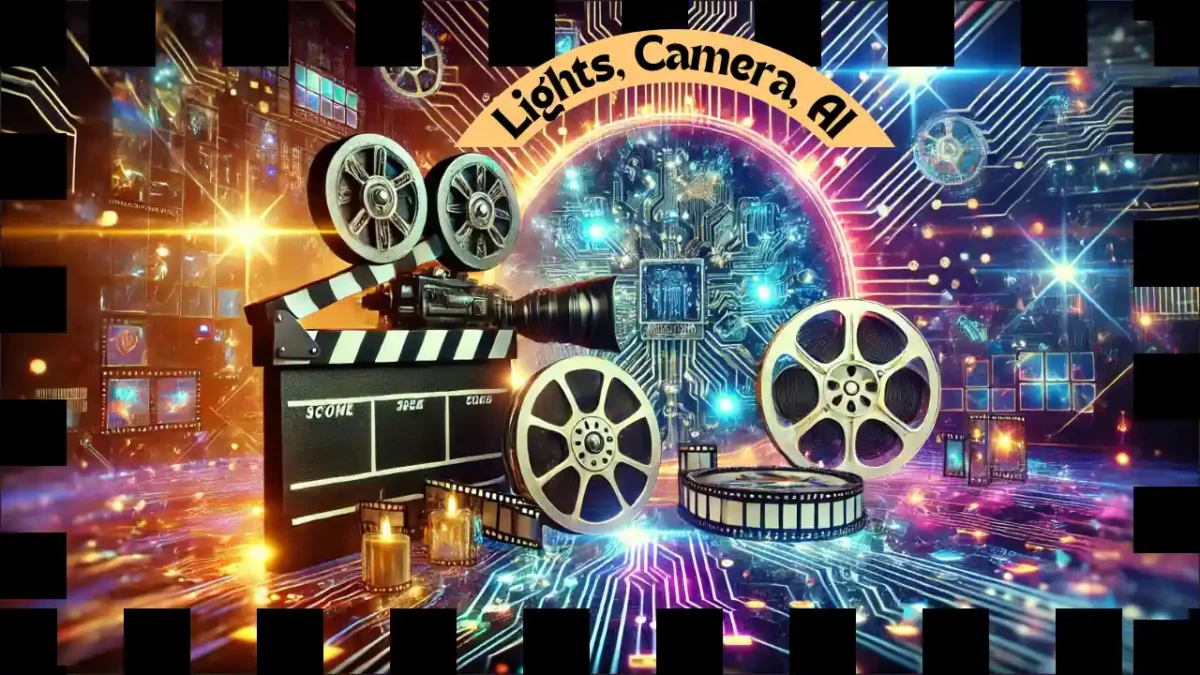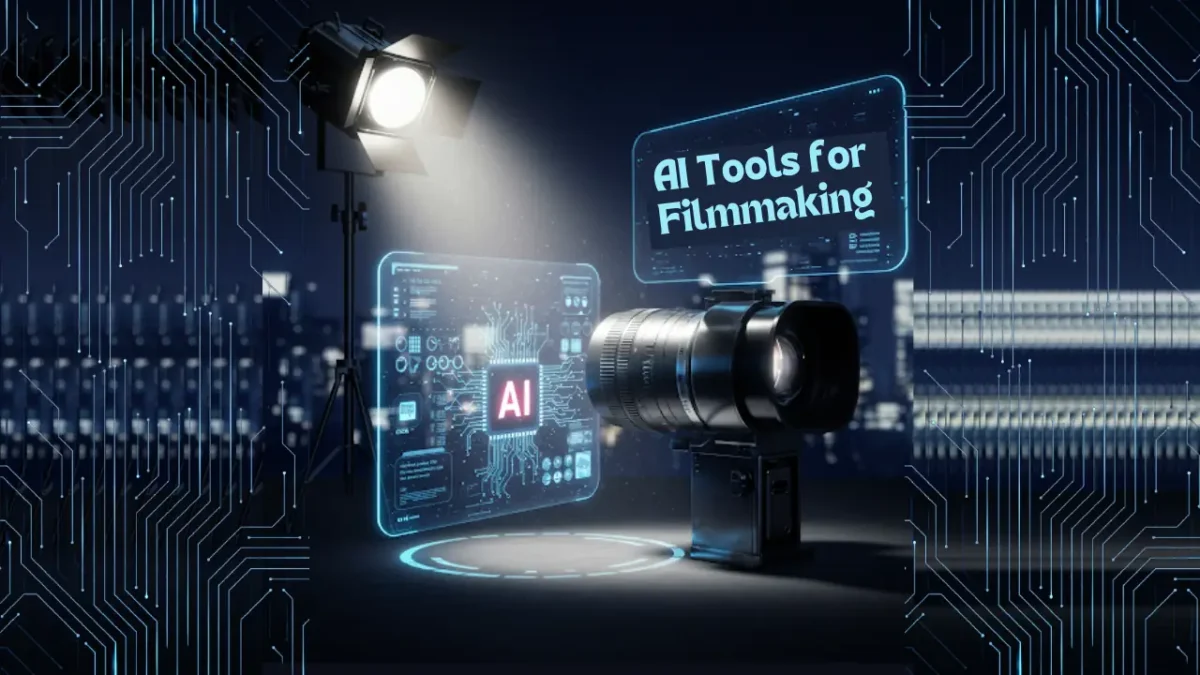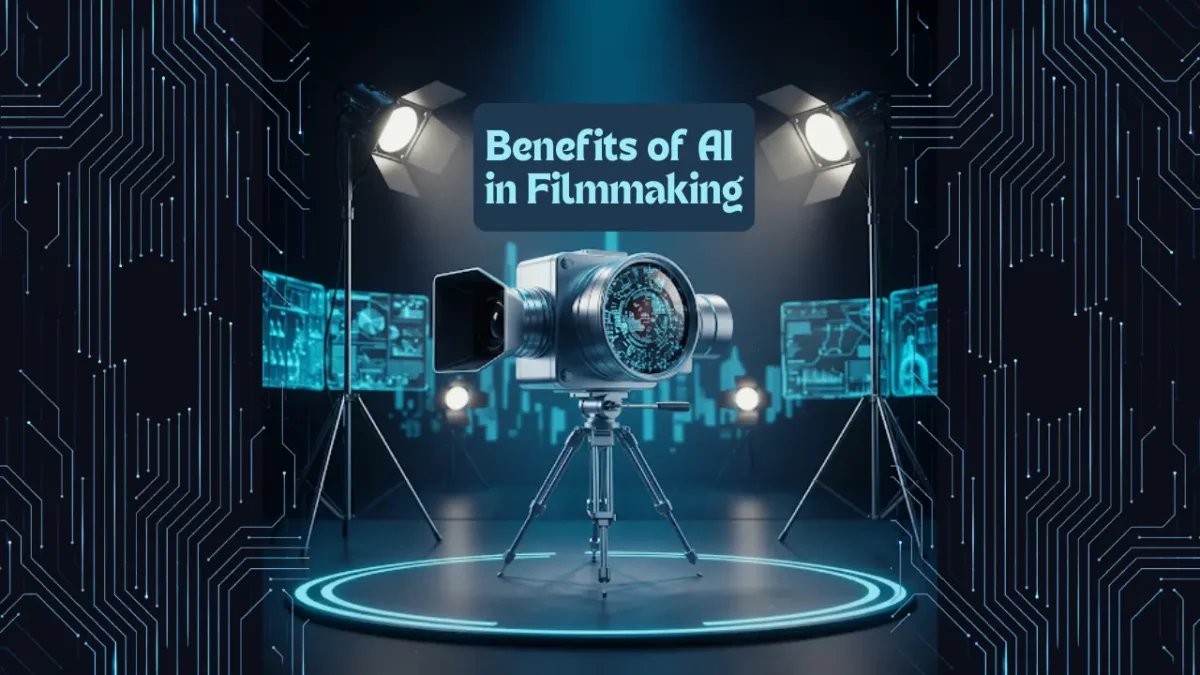Lights, Camera, AI: How AI is Transforming Filmmaking
Artificial intelligence (AI) is transforming everyday tasks by giving computers the ability to think and create in ways that were once thought impossible.
In the world of movies, “Lights, Camera, AI” captures this fresh, dynamic shift. AI is joining directors, writers, and editors on set, making film-making faster, more inventive, and much more fun.
From assisting with scriptwriting and editing to generating stunning visual effects, AI is transforming how films are made, opening up fresh possibilities for storytelling and artistic expression.
I believe this integration of technology and creativity is reshaping the future of cinema, making it more dynamic and accessible than ever before.

The AI Wave in Filmmaking
AI is not just a supplementary tool but a driving force that is reshaping the entire filmmaking process. Traditional filmmaking is undergoing a significant transformation due to AI, which is now deeply woven into the creative process. Rather a completely new genre of AI Filmmaking has emerged.
AI tools are being used to generate and refine screenplays. A standout example is “One Last Wish” by Edmond Yang, which emerged from the Project Odyssey competition.
This film showcased how AI can offer unexpected plot twists and creative narrative ideas that challenge conventional storytelling. This is quite fascinating how these tools are opening up new avenues for writers, allowing them to explore concepts they might never have considered on their own.
AI’s influence in Filmmaking is most visually apparent in the realm of special effects. Tools like Google’s Veo 2 and OpenAI’s Sora among others are pushing the boundaries by creating stunning 4K visuals and intricate CGI elements.
AI technology allows even small-budget productions to achieve effects that once belonged exclusively to major studios. It’s truly exciting to see how AI is democratizing high-end visual effects, making them accessible to a broader range of filmmakers.
Try ChatGPT unblocked – AI tool to get deeper, more accurate, and up-to-date knowledge on any topic of your interest.
How Film Festivals and Competitions Encouraging AI Film Making
Innovative film festivals and competitions that spotlight AI projects are revolutionizing the way creative talent is recognized. Rather than relying on a select group of industry insiders, these events invite public participation and welcome submissions from around the globe, making the awards process more accessible and diverse.
For instance, the Escape Awards uses an online platform called Escape.ai to allow anyone – from aspiring filmmakers to avid moviegoers – to vote and participate. This open approach not only broadens the talent pool but also ensures that films are evaluated by a diverse audience, reflecting a more inclusive perspective.
I believe this shift democratizes film recognition, providing fresh opportunities for voices that might have been overlooked in traditional settings.
Similarly, Project Odyssey has captured global attention by offering significant financial backing – $78,000 in prizes and $800,000 in AI tool trials – and drawing over 4,500 submissions from 166 countries.
This initiative not only highlights the creative potential of AI in filmmaking, as seen in standout works like “One Last Wish” by Edmond Yang but also emphasizes the worldwide interest in leveraging AI for storytelling.
It’s exciting to see how such a broad participation encourages a rich exchange of ideas and cultural perspectives.
Moreover, strategic moves such as the acquisition of Curious Refuge by AI studio Promise have spurred the launch of the first AI Animation Competition. This event, complete with cash prizes and development opportunities, is tailored to nurture emerging talent and further blur the lines between technology and traditional artistry.
I believe these initiatives represent a pivotal evolution in the film industry, ushering in an era marked by unparalleled global connectivity and a steadfast commitment to genuine inclusivity.
Big Players and Game-Changing Tools for AI Filmmaking
As AI continues to reshape the filmmaking landscape, major technology players are rolling out innovative tools that empower creators to push the boundaries of storytelling.
Initiatives like the Escape Awards are redefining what it means to celebrate films, by recognizing projects that creatively blend human vision with AI.
Take Project Odyssey, for example. This initiative is making waves by offering generous funding and access to over $800,000 in free AI tool trials.
It’s more than just a contest – it’s a launchpad for filmmakers worldwide, fostering an environment where creative risks are encouraged, and groundbreaking ideas can flourish. Films like “One Last Wish” have emerged from these efforts, showcasing the power of AI-enhanced storytelling.
AI Tools for Filmmaking
AI is radically transforming filmmaking, offering tools that empower creators to push creative boundaries and streamline every step of production. Here’s a closer look at some of the most influential AI tools reshaping the industry:

Google’s Veo 2
Google’s Veo 2 stands out with its ability to generate high-quality 4K visuals through advanced AI video generation. This AI tool for filmmaking enables real-time rendering and the creation of intricate CGI sequences, making it possible for filmmakers to produce complex visual effects that were once exclusive to high-budget productions.
Indie projects can leverage Veo 2 to craft immersive digital environments and seamlessly blend live-action with computer-generated imagery – transforming the visual storytelling landscape.
OpenAI’s Sora
Sora is emerging as a powerful platform in the AI filmmaking ecosystem. Its real-time editing and dynamic scene creation capabilities allow filmmakers to visualize and modify shots on the fly. Film directors can use Sora during a live shoot to immediately adjust scene composition and lighting, significantly reducing post-production time.
Sora’s intelligent algorithms even suggest optimal cuts and transitions, ensuring a cohesive narrative flow while preserving the director’s artistic vision.
Adobe Sensei and DaVinci Resolve
Adobe Sensei, integrated into Adobe Premiere Pro and After Effects, utilizes machine learning to automate tasks such as color grading, audio cleanup, and scene segmentation. Similarly, DaVinci Resolve harnesses AI to perform shot matching and face recognition, ensuring consistent visual quality throughout a film.
A filmmaker can employ Adobe Sensei to uniformly color-correct a series of challenging outdoor shots, saving weeks of manual adjustments and achieving a polished, professional look.
Runway ML
Runway ML democratizes high-end visual effects by offering an intuitive suite of AI-powered tools for real-time video effects, style transfers, and even 3D object generation. Its ease of use has made it a favorite among independent filmmakers.
This AI Filmmaking tool can transform live-action footage into a stylized, painterly sequence, effectively merging traditional cinematography with digital artistry. This capability opens up new avenues for visual expression that were previously beyond reach for smaller studios.
NVIDIA
NVIDIA is not only a leader in hardware but also in AI-powered visual effects. Their GAN-based image synthesis technology enables the creation of hyper-realistic textures and landscapes, drastically reducing the manual effort required for CGI.
Film-makers can use NVIDIA’s technology to create expansive, otherworldly environments that enhance the narrative’s fantastical elements. This kind of innovation expands the creative palette for filmmakers, allowing for more ambitious visual storytelling.
OpenAI and Creative Language Models
Beyond visual tools, AI models like OpenAI’s GPT series are revolutionizing scriptwriting and dialogue generation. These ChatGPT models can provide novel narrative ideas and assist in overcoming writer’s block by offering multiple creative directions.
While they aren’t a replacement for human creativity, they serve as invaluable brainstorming partners, sparking new storylines and enhancing the overall creative process.
Discover how to use an AI tool like ChatGPT the best possible way to get the most out of it.
Equally noteworthy are the contributions from other industry leaders like Lambda, Civitai, and ElevenLabs. These companies offer robust platforms that assist with everything from generating engaging scripts to creating complex CGI, helping filmmakers streamline production while exploring creative possibilities that were previously unimaginable.
AI Tools
AI Marketing Tools
AI Business Tools
What are the Benefits and Challenges of Using AI in Filmmaking?
AI is opening up exciting new avenues in filmmaking, but it also brings its share of hurdles. I believe that while AI offers transformative benefits for the film industry, the key will be to find the right balance between embracing AI technology and preserving the creative, human element that makes films truly engaging.
Benefits of Using AI in Filmmaking
The integration of AI in filmmaking offers a multifaceted range of benefits. From significantly faster production cycles and cost-effective post-production to groundbreaking visual effects and creative storytelling, AI is reshaping the industry.

As these technologies continue to evolve, they promise not only to streamline the filmmaking process but also to inspire a new era of artistic expression that leverages the best of both human creativity and machine intelligence.
The following are the prominent advantages of using AI in the filmmaking process:
Accelerated Production and Post-Production
AI-driven editing software can analyze hours of raw footage and streamline the post-production process. For example, tools like Adobe Premiere Pro’s Sensei and DaVinci Resolve’s machine-learning features can automatically color-grade scenes, match shots, and even suggest edits that align with the intended mood of the film.
This automation has allowed some indie filmmakers to cut down post-production times dramatically -from months to just weeks – thereby reducing costs and speeding up release schedules.
Enhanced Visual Effects and Real-Time Rendering
AI is revolutionizing visual effects by enabling real-time rendering and the creation of hyper-realistic CGI. AI Technologies such as NVIDIA’s GAN-based image synthesis and advanced tools like Google’s Veo 2 are pushing creative boundaries, allowing filmmakers to generate detailed digital environments and characters with minimal manual input.
For instance, some productions have used AI to de-age actors or seamlessly blend live-action with CGI, providing flexibility and opening up new storytelling possibilities that were previously cost-prohibitive.
Creative Scriptwriting and Story Generation
Advanced language models, like those developed by OpenAI and other companies, are now being used in scriptwriting to overcome writer’s block and generate novel plot ideas. Screenwriters can use these AI tools to explore multiple narrative pathways or even create entire rough drafts that serve as a starting point for further human refinement.
Experimental projects have already demonstrated how AI-generated scripts can lead to innovative short films and pilot episodes, showcasing a blend of algorithmic creativity with human storytelling nuance.
Democratization of AI Filmmaking Tools
One of the most transformative benefits of AI is its role in democratizing filmmaking. High-quality editing, visual effects, and sound design tools that were once exclusive to big-budget studios are now accessible to independent filmmakers.
Platforms like Runway ML offer intuitive AI-powered software that empowers creators with limited resources to produce professional-level content. This democratization is leveling the playing field, allowing emerging talents to compete on a global stage and bringing fresh perspectives to cinema.
Data-Driven Insights and Enhanced Audience Engagement
AI is also making an impact on film marketing and distribution. By analyzing vast amounts of audience data, AI can help predict trends, optimize release strategies, and tailor marketing campaigns to target specific demographics.
This data-driven approach not only maximizes a film’s commercial potential but also enables filmmakers to better understand viewer preferences, ensuring that the content resonates with audiences. Tools that monitor social media sentiment and engagement are increasingly used to refine promotional strategies, thereby enhancing overall audience interaction.
Innovation and Experimentation in Storytelling
Beyond the technical improvements, AI is sparking a wave of innovation in narrative techniques. Some experimental films have used AI to create dynamic, non-linear storylines that adapt based on viewer choices – blurring the boundaries between traditional cinema and interactive art.
This approach has given rise to entirely new genres and storytelling methods, as filmmakers harness AI to experiment with formats that invite audience participation and create more immersive experiences.
Check 50 best AI prompts to find successful startup ideas in 2025.
Challenges of Using AI in Filmmaking
While AI brings a host of benefits to film production, the challenges it presents – from ensuring narrative consistency to managing technical and ethical issues – demand a thoughtful and balanced approach.
Filmmakers must navigate these hurdles carefully to fully harness AI’s capabilities while preserving the artistry that makes cinema resonate with audiences.
Maintaining Narrative Consistency and Depth
AI-generated scripts and dialogue can sometimes lack the nuanced continuity of a story. For example, early attempts at using AI for screenwriting have occasionally resulted in disjointed plots or inconsistent character voices.
While an AI might suggest an intriguing plot twist, it may not fully grasp the emotional arc or subtle context needed to keep a narrative engaging. A film generated by AI may require extensive human revision to align the storytelling with the intended tone and depth – indicating the ongoing need for human oversight in creative decision-making.
Overreliance and the Risk of Homogenization
As filmmakers adopt AI tools for tasks ranging from editing to special effects, there’s a risk that overreliance on these technologies could lead to a homogenization of creative output. AI algorithms often learn from existing data, which might inadvertently lead to recycled ideas or stylistic clichés.
For instance, if multiple productions start using the same AI-generated editing techniques or visual effects filters, films might begin to look and feel similar, potentially stifling unique artistic expression.
Quality Control and Technical Integration
Integrating AI into the complex workflow of film production is not without technical hurdles. Advanced AI tools, like those for real-time rendering or visual effects generation, can sometimes produce output with artifacts or inconsistencies that disrupt the visual narrative.
Filmmakers must invest additional time and resources to manually correct these issues, which can offset some of the efficiency gains. Moreover, aligning AI systems with existing production tools often requires specialized expertise, making the transition a challenging endeavour.
Ethical and Copyright Considerations
The use of AI in filmmaking raises important ethical questions and copyright concerns. AI systems are trained on large datasets, which might include copyrighted materials without proper attribution. This can lead to legal disputes over intellectual property rights, particularly when AI-generated content closely mimics the style or substance of existing works.
Additionally, the potential misuse of deepfake technology to manipulate or misrepresent reality poses significant ethical dilemmas for filmmakers and audiences alike.
Balancing Innovation with the Human Touch
Perhaps the most fundamental challenge is striking the right balance between leveraging AI and preserving the creative vision of human storytellers. While AI can suggest innovative ideas and streamline technical tasks, it lacks the intuitive understanding of human emotion and cultural nuance that experienced filmmakers bring to their craft.
Maintaining this balance is crucial; the best results often emerge from a collaborative process where AI acts as a creative assistant rather than a full replacement for human ingenuity.
Final Thoughts
AI is not just a tool; it’s a catalyst that’s reshaping the entire filmmaking landscape. From speeding up production and opening new creative possibilities to democratizing high-end filmmaking techniques, the influence of AI is evident in every step of the creative process.
I see this as a remarkable opportunity for filmmakers to merge their unique visions with technological innovations, creating stories that captivate audiences in entirely new ways.
However, as with any revolutionary change, there are challenges to overcome. Balancing AI’s capabilities with the essential human touch in storytelling is key.
The journey ahead involves not only embracing these advanced tools but also ensuring that the art of filmmaking remains deeply rooted in human creativity and emotion.
I’m excited to see how the film industry navigates this dynamic interplay between technology and artistry, ultimately leading to a richer, more diverse cinematic landscape.
Albert Haley
Albert Haley, the enthusiastic author and visionary behind ChatGPT 4 Online, is deeply fueled by his love for everything related to artificial intelligence (AI). Possessing a unique talent for simplifying complex AI concepts, he is devoted to helping readers of varying expertise levels, whether newcomers or seasoned professionals, in navigating the fascinating realm of AI. Albert ensures that readers consistently have access to the latest and most pertinent AI updates, tools, and valuable insights. Author Bio

